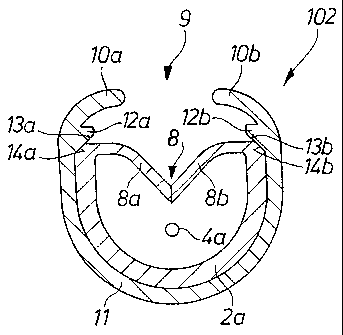Some of the information on this Web page has been provided by external sources. The Government of Canada is not responsible for the accuracy, reliability or currency of the information supplied by external sources. Users wishing to rely upon this information should consult directly with the source of the information. Content provided by external sources is not subject to official languages, privacy and accessibility requirements.
Any discrepancies in the text and image of the Claims and Abstract are due to differing posting times. Text of the Claims and Abstract are posted:
| (12) Patent: | (11) CA 2646957 |
|---|---|
| (54) English Title: | CANNULA WITH PROTECTIVE CASING |
| (54) French Title: | CANULE A GAINE PROTECTRICE |
| Status: | Granted and Issued |
| (51) International Patent Classification (IPC): |
|
|---|---|
| (72) Inventors : |
|
| (73) Owners : |
|
| (71) Applicants : |
|
| (74) Agent: | NORTON ROSE FULBRIGHT CANADA LLP/S.E.N.C.R.L., S.R.L. |
| (74) Associate agent: | |
| (45) Issued: | 2011-01-04 |
| (86) PCT Filing Date: | 2007-03-16 |
| (87) Open to Public Inspection: | 2007-10-04 |
| Examination requested: | 2009-03-12 |
| Availability of licence: | N/A |
| Dedicated to the Public: | N/A |
| (25) Language of filing: | English |
| Patent Cooperation Treaty (PCT): | Yes |
|---|---|
| (86) PCT Filing Number: | PCT/DE2007/000502 |
| (87) International Publication Number: | WO 2007110043 |
| (85) National Entry: | 2008-09-22 |
| (30) Application Priority Data: | ||||||
|---|---|---|---|---|---|---|
|
The invention relates to a cannula, preferably equipped with a cannula holder for, in particular a blood sampling device, which comprises a pivotable protective housing (102) for a free end of the cannula. Said protective housing (102) is closed on the periphery except for a cannula insertion opening (8) provided between opposing side walls. Said insertion opening is produced by at least one pair of lamella (8a, 8b), formed on the side walls, the lamella tapering towards one another in the manner of a funnel and forming an expandable funnel slot. The protective housing (102) comprises two housing parts which can be inserted into each other. The inner housing (2a) comprises the pair of lamella (8a, 8b) and an outer housing (11), which surrounds the inner housing (2a), is embodied as a sleeve that is less elastic than the inner housing (2a).
L'invention concerne une canule, comprenant de préférence, un porte-canule utilisé en particulier pour un dispositif de prélèvement sanguin, qui présente un logement de protection (102), pouvant pivoter, pour une extrémité libre de la canule. Ledit logement de protection est entièrement fermé sur sa périphérie, à l'exception d'un orifice d'insertion de la canule (8) placé entre les parois latérales opposées l'une à l'autre. Ledit orifice d'insertion est produit par une paire de lamelles (8a, 8b) formées sur les parois latérales, les lamelles se dirigeant l'une vers l'autre à la manière d'un entonnoir, ce qui forme une entaille d'entonnoir extensible. Le logement de protection (102) comprend deux parties de logement insérées l'une dans l'autre, un logement intérieur (2a) présentant la paire de lamelles (8a, 8b) et un logement extérieur (11) entourant le logement intérieur sert à former une enveloppe moins élastique que le logement intérieur (2a).
Note: Claims are shown in the official language in which they were submitted.
Note: Descriptions are shown in the official language in which they were submitted.

2024-08-01:As part of the Next Generation Patents (NGP) transition, the Canadian Patents Database (CPD) now contains a more detailed Event History, which replicates the Event Log of our new back-office solution.
Please note that "Inactive:" events refers to events no longer in use in our new back-office solution.
For a clearer understanding of the status of the application/patent presented on this page, the site Disclaimer , as well as the definitions for Patent , Event History , Maintenance Fee and Payment History should be consulted.
| Description | Date |
|---|---|
| Common Representative Appointed | 2019-10-30 |
| Common Representative Appointed | 2019-10-30 |
| Grant by Issuance | 2011-01-04 |
| Inactive: Cover page published | 2011-01-03 |
| Inactive: Final fee received | 2010-10-18 |
| Pre-grant | 2010-10-18 |
| Notice of Allowance is Issued | 2010-07-09 |
| Letter Sent | 2010-07-09 |
| Notice of Allowance is Issued | 2010-07-09 |
| Inactive: Approved for allowance (AFA) | 2010-07-07 |
| Inactive: Acknowledgment of national entry - RFE | 2010-03-15 |
| Letter Sent | 2009-04-15 |
| Request for Examination Requirements Determined Compliant | 2009-03-12 |
| All Requirements for Examination Determined Compliant | 2009-03-12 |
| Request for Examination Received | 2009-03-12 |
| Inactive: Acknowledgment of national entry correction | 2009-02-12 |
| Inactive: Cover page published | 2009-01-28 |
| Inactive: IPRP received | 2009-01-23 |
| Inactive: Notice - National entry - No RFE | 2009-01-23 |
| Inactive: First IPC assigned | 2009-01-21 |
| Application Received - PCT | 2009-01-20 |
| National Entry Requirements Determined Compliant | 2008-09-22 |
| Inactive: Declaration of entitlement - PCT | 2008-09-12 |
| Application Published (Open to Public Inspection) | 2007-10-04 |
There is no abandonment history.
The last payment was received on 2010-03-09
Note : If the full payment has not been received on or before the date indicated, a further fee may be required which may be one of the following
Please refer to the CIPO Patent Fees web page to see all current fee amounts.
Note: Records showing the ownership history in alphabetical order.
| Current Owners on Record |
|---|
| SARSTEDT AG & CO. |
| Past Owners on Record |
|---|
| WALTER SARSTEDT |